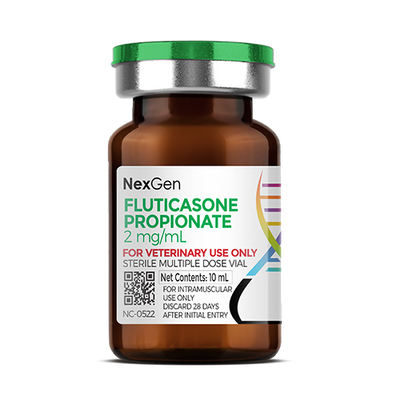
Fluticasone Propionate 2 mg/mL, Injectable Solution, 50mL
Login for pricing
- Brand
- NexGen
- SKU:
- NC-0239
- Product Type:
- Injectable
- Size:
- 50ml
- Administration:
- Intramuscular
Nearly all horse owners and managers will be familiar with heaves, a chronic, non-infectious airway condition affecting horses. It is also called recurrent airway obstruction, or RAO. This condition usually occurs in horses more than 6 years of age.1 There are also other names to describe airway conditions form which horses suffer, including inflammatory airway disease (IAD), chronic bronchitis, allergic airway disease and small airway disease. This collection of inflammatory airway conditions was formerly referenced as chronic obstructive pulmonary disease or COPD, not to be confused with COPD in humans, which is usually of differing etiology.
All of these are included under the umbrella of equine asthma.2 Horses with any of the above mentioned conditions have airway inflammation that gives rise to recognizable signs ranging from decreased performance to a cough, nasal discharge or marked respiratory distress.1 A horse that stands in its stall with nostrils flaring and sides heaving and desperately trying to get air is almost certainly suffering from heaves.
More often than not, heaves or equine asthma is the result of an allergic reaction to inhaled particles related to the environmental conditions in which horses are regularly kept. These are nearly always environments with a high level of particulate (dust). Once these dust particles are inhaled, an allergic reaction arises in the horse, which causes the small airways in the lung tissue to become narrowed and eventually obstructed.1,2
Symptoms of Equine Asthma
Usually, one of the first clinical signs noted by an owner or manager will be an occasional cough. As the condition progresses, the symptoms become more pronounced and will include an intolerance to exercise, an increased respiratory rate, wheezing and flaring of the nostrils and nasal discharge. The horse will have to work harder to breathe due to the obstruction of the small airways. This causes the horse to use its abdominal muscles more vigorously while breathing, resulting in the visible enlargement of these muscles and the formation of the characteristic “heave line.”1 Even mild cases of heaves tend to be easier to identify in performance horses (Thoroughbreds, Quarter Horses or barrel racers) due to their increased demand for oxygen.
While asthma is often as thought of as a condition stemming from allergies in humans, very often, horses with heaves have no signs of allergies. Instead, IAD in these horses is similar to what is called occupational asthma.2 As stated above, the poor air quality, agricultural environments and farms that horses, humans and other creatures share are often replete with organic dust and other particulates that can cause profound irritation to the airways of even non-allergic humans and horses. It should be noted that in some of the available literature IAD is differentiated from heaves, with the latter reported as having an allergic component.1,2
Fluticasone for Horses
Whatever the designation of this collection of symptoms, the condition is treatable, but not curable.2 With accurate diagnosis, proper treatment and environmental improvements, it can be successfully managed in most horses. At present, corticosteroids currently are the most effective treatment available to control heaves in horses, and systemically-administered corticosteroids have been shown to alter the immune response in horseas and other species.3
Where to buy Fluticasone
Fluticasone is available in the U.S. through several pharmaceutical manufacturers and through veterinary custom compounding companies.
Please consult your veterinarian prior to beginning any treatment regimen.
FOR RX ONLY: A valid prescription from a licensed veterinarian is required for dispensing this medication.
3Dauvillier J., et. al. Effect of long-term fluticasone treatment on immune function in horses with heaves. J Vet Intern Med. 2011 May-Jun; 25(3):549-57.




















